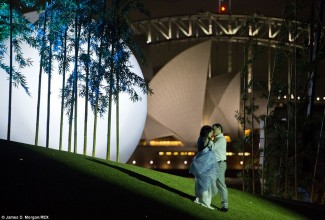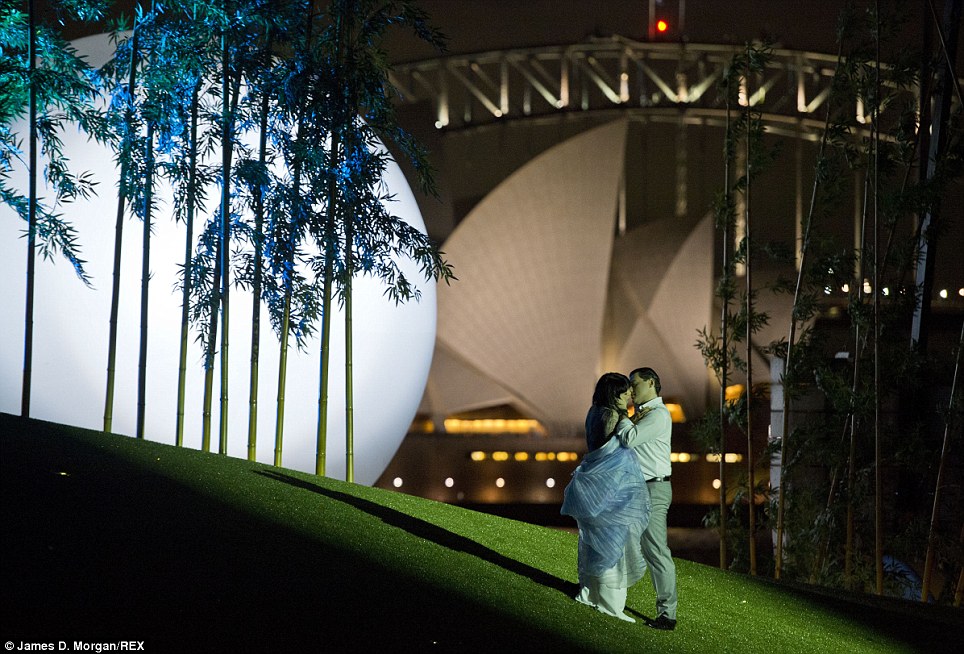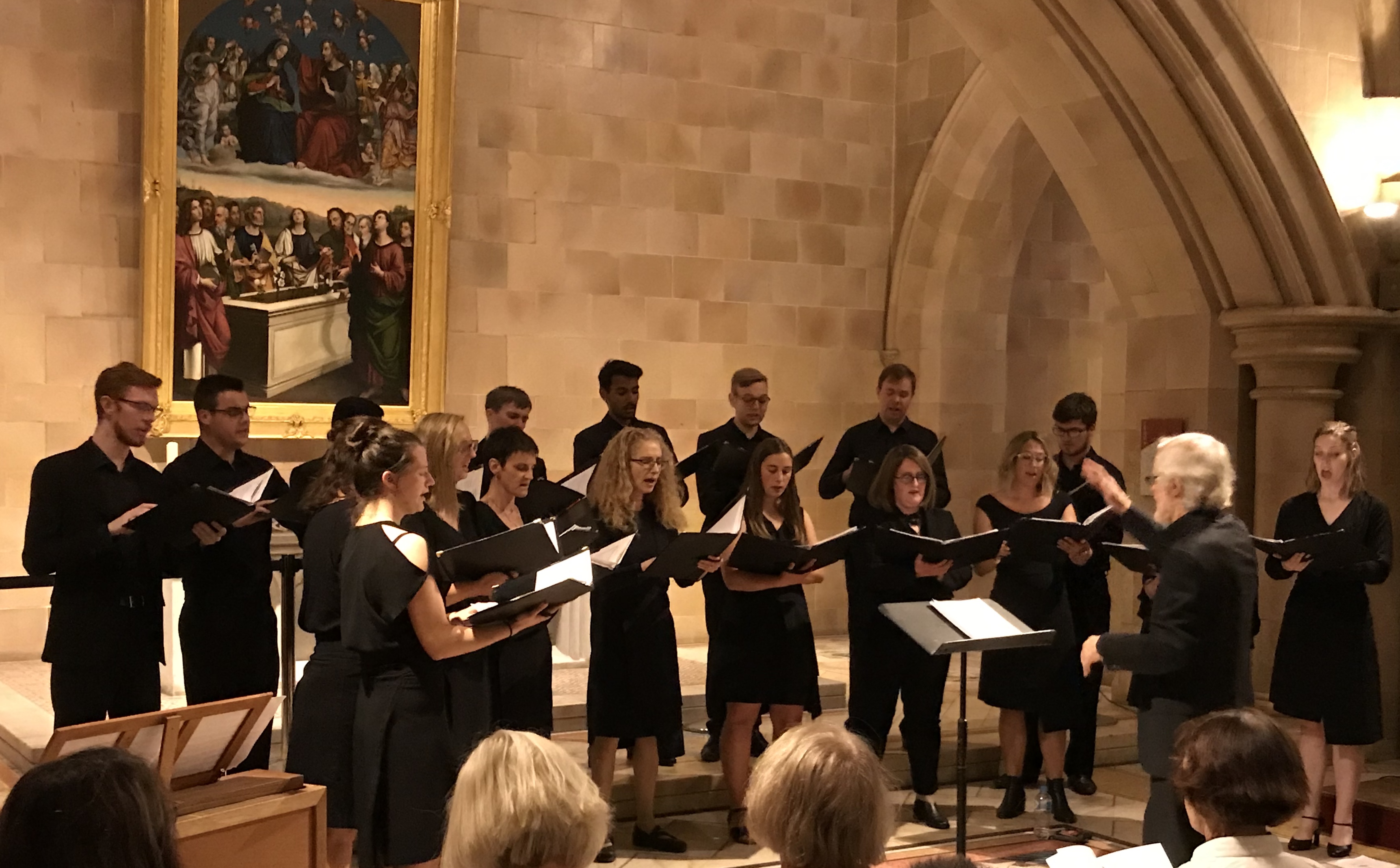Review: Madame Butterfly, Handa Opera On Sydney Harbour – Excellent Singing And A Scenic Triumph

Madama Butterfly,
G Puccini
Handa Opera On Sydney Harbour
23 March 2014
This is the third year that Opera Australia has mounted a production on the waters of Sydney Harbour in Farm Cove. The location remains unsurpassable: the harbour waters in the foreground, then the lights of the city and the Opera House, and a glorious sunset in the background.
This year’s production was Puccini’s Madama Butterfly. Initial fears that such an intimate opera would be unsuited to this spectacular outdoor setting proved mostly unfounded. The production is directed by Àlex Ollé of the Spanish company La Fura dels Baus who are renowned for their innovative but often controversial productions. The set designed by Alfons Flores for the first act turns the large stage area into a green field, rising to a grassy hill surmounted by a stand of bamboo. This was evocatively lit by Alexander Koppelmann who produced magically beautiful effects for the lyrical passages, with particularly exquisite backlighting of the shimmering bamboo fronds. The set was wonderfully convincing when the text spoke of climbing the hill to Butterfly’s house, then for the references to the harbour and the sea. All this was literally laid before us while the harbour breeze obligingly blew the festive wedding draperies. It was a scenic triumph.
For the first time in the Handa opera series there is a major change of set between the two halves and the transition during the half-hour interval made fascinating viewing. In this production Pinkerton is a modern property developer who destroys the culture and landscape into which he intrudes. Butterfly’s house became part of a rundown, unfinished housing estate, and the cranes for the stage machinery now appeared to be an integral part of the unfinished building works. The dilapidated scene underlined Pinkerton’s loss of interest in the venture although the metaphor was sometimes laboured and not always convincing. Later in the act, it was a nice idea to show Butterfly’s son (Samuel Park), playing with friends outside the house before he is mentioned in the text. At the end of the opera, his separation from his mother was the heartrending climax of the drama, leaving Butterfly’s off-stage suicide as something of an anticlimax. The costuming by Lluc Castells served the production concept well. Butterfly’s second act American clothes forcefully underlined the pathos of her situation. One wonders, however why the costume for the Bonze, defender of traditional values, was distinctly non-traditional.
Musically, the results were mixed since amplified sound can never capture the glory of instruments and voices produced naturally. In this case, the violins sounded lamentably metallic and tinny and the close balance only emphasised their occasional lack of unanimity. The lower instruments also suffered from a boomy bass sound. The wind instruments fared better but the brass seemed somewhat off-mike. The balance vastly favoured the voices with the orchestra providing a recessed background which gave the unfortunate impression of being produced by a smaller number of players.
The singers, however, were excellent. Cio-Cio-San was sung by the Japanese soprano Hiromi Omura who was dramatically and musically outstanding. In this production, Butterfly is a little wiser than her 15 years might suggest, but her trust in Pinkerton was still absolute. Omura sang sensitively and she varied her tone and dynamical range impressively. Her long legato phrases rode magnificently over Puccini’s orchestral climaxes.
Pinkerton was sung by the Russian Georgy Vasiliev whose voice is ideally suited to Puccini. His vibrant tone was thrilling, especially in the duet which closes the first act. The amplification gave the impression, however, that he was singing loudly all the time and his interpretation would have benefited from greater dynamic shading. He was also a rather cool lover in the first act but perhaps this was the director’s intention.
Suzuki is often overlooked as a secondary role, but she is crucial to the opera realising its full dramatic potential. The part was sung by Victoria Lambourn and her concern and support for Butterfly were evident throughout. Her full but focused sound suited the role well.
Sharpless was sung by Michael Honeyman. Vocally strong, he also conveyed the consul’s concern about the turn of events right from the beginning. Goro was well acted and sung by Graeme Macfarlane without the whining sometimes associated with the role. The minor characters were all dramatically and vocally strong.
The chorus sang well in their brief appearances. During the humming chorus they became homeless people being escorted across the stage. This seemed somewhat unmotivated and distracted attention from the moonlit, night-watch scene that Puccini was creating.
The orchestra, submerged under the stage was conducted by Brian Castles-Onion who shaped the score sensitively and generally succeeded very well in coordinating the orchestra with the singers on the stage above him.
In summary, this Handa production of Madama Butterfly is another in the string of artistic successes which Opera Australia have achieved on the harbour. It provides a wonderful evening of spectacle, superb singing and thought-provoking drama. Performances continue until 13 April.
Larry Turner for SoundsLikeSydney©
Larry Turner has been singing in choirs for many years – both in Sydney and London. He is an avid attendee of operas and concerts, with an emphasis on vocal music. He particularly enjoys music from both the great a capella period and the baroque – especially the lesser-known works of Bach and Handel. He has written programme notes for Sydney Philharmonia, the Intervarsity Choral Festival and the Sydneian Bach Choir and is currently part of a team researching the history of Sydney Philharmonia for its forthcoming centenary.







